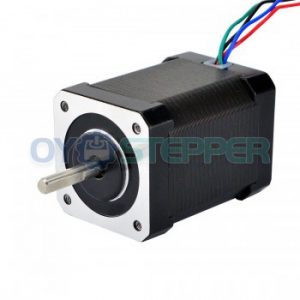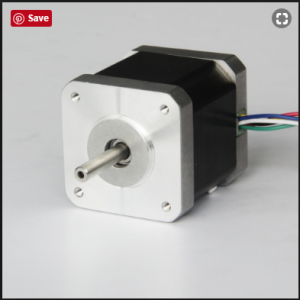There are three basic types of step motors: variable reluctance, permanent magnet, and hybrid. This discussion will concentrate on the hybrid stepper motor, since these step motors combine the best characteristics of the variable reluctance and permanent magnet motors. They are constructed with multi-toothed stator poles and a permanent magnet rotor. Standard hybrid motors have 200 rotor teeth and rotate at 1.8º step angles. Because they exhibit high static and dynamic torque and run at very high step rates, hybrid step motors are used in a wide variety of commercial applications including computer disk drives, printers/plotters, and CD players. Some industrial and scientific applications of stepper motors include robotics, machine tools, pick and place machines, automated wire cutting and wire bonding machines, and even precise fluid control devices.

HALF STEP—half step simply means that the step motor is rotating at 400 steps per revolution. In this mode, one winding is energized and then two windings are energized alternately, causing the rotor to rotate at half the distance, or 0.9°. Although it provides approximately 30% less torque, half-step mode produces a smoother motion than full-step mode.
FULL STEP—standard hybrid stepping motors have 200 rotor teeth, or 200 full steps per revolution of the motor shaft. Dividing the 200 steps into the 360° of rotation equals a 1.8° full step angle. Normally, full step mode is achieved by energizing both windings while reversing the current alternately. Essentially one digital pulse from the driver is equivalent to one step.
Linear Motion Control—the rotary motion of a stepper motor can be converted to linear motion using a lead screw/worm gear drive system. The lead, or pitch, of the lead screw is the linear distance traveled for one revolution of the screw. If the lead is equal to one inch per revolution, and there are 200 full steps per revolution, then the resolution of the lead screw system is 0.005 inches per step. Even finer resolution is possible by using the step motor/drive system in microstepping mode.
 The stepper motor for sale driver receives step and direction signals from the indexer or control system and converts them into electrical signals to run the step motor. One pulse is required for every step of the motor shaft. In full step mode, with a standard 200-step motor, 200 step pulses are required to complete one revolution. The speed of rotation is directly proportional to the pulse frequency. Some drivers have an on-board oscillator which allows the use of an external analog signal or joystick to set the motor speed. The choice of a step motor depends on the application’s torque and speed requirements. Use the motor’s torque-speed curve (found in each drive’s specifications) to select a motor that will do the job. Every stepper drive in the line shows the torque-speed curves for that drive’s recommended motors. If your torque and speed requirements can be met by multiple step motors, choose a drive based upon the needs of your motion system- step/direction, stand-alone programmable, analog inputs, microstepping- then choose one of the recommended motors for that drive. The recommended motor list is based on extensive testing by the manufacturer to ensure optimal performance of the step motor and drive combination.
The stepper motor for sale driver receives step and direction signals from the indexer or control system and converts them into electrical signals to run the step motor. One pulse is required for every step of the motor shaft. In full step mode, with a standard 200-step motor, 200 step pulses are required to complete one revolution. The speed of rotation is directly proportional to the pulse frequency. Some drivers have an on-board oscillator which allows the use of an external analog signal or joystick to set the motor speed. The choice of a step motor depends on the application’s torque and speed requirements. Use the motor’s torque-speed curve (found in each drive’s specifications) to select a motor that will do the job. Every stepper drive in the line shows the torque-speed curves for that drive’s recommended motors. If your torque and speed requirements can be met by multiple step motors, choose a drive based upon the needs of your motion system- step/direction, stand-alone programmable, analog inputs, microstepping- then choose one of the recommended motors for that drive. The recommended motor list is based on extensive testing by the manufacturer to ensure optimal performance of the step motor and drive combination.